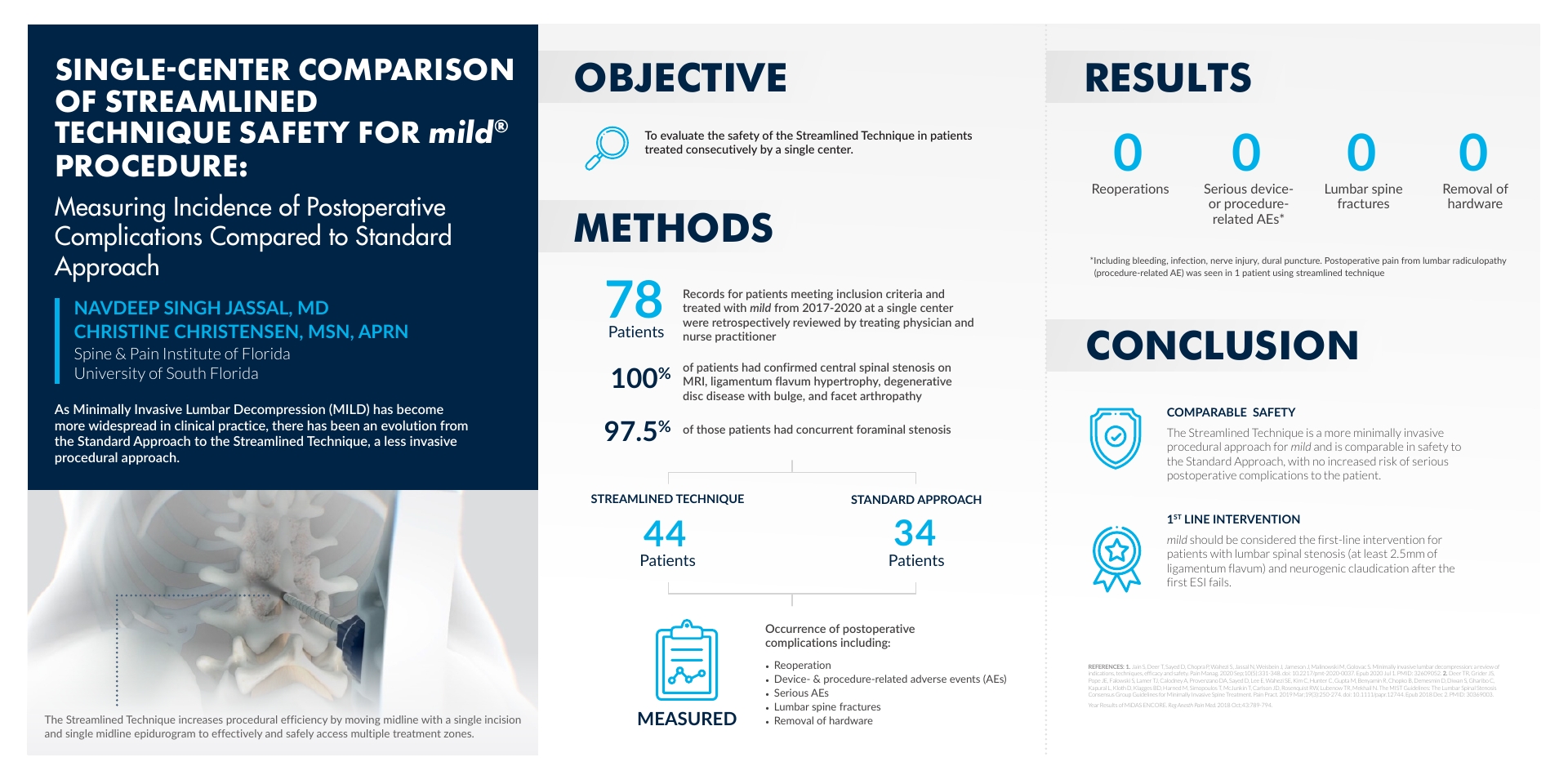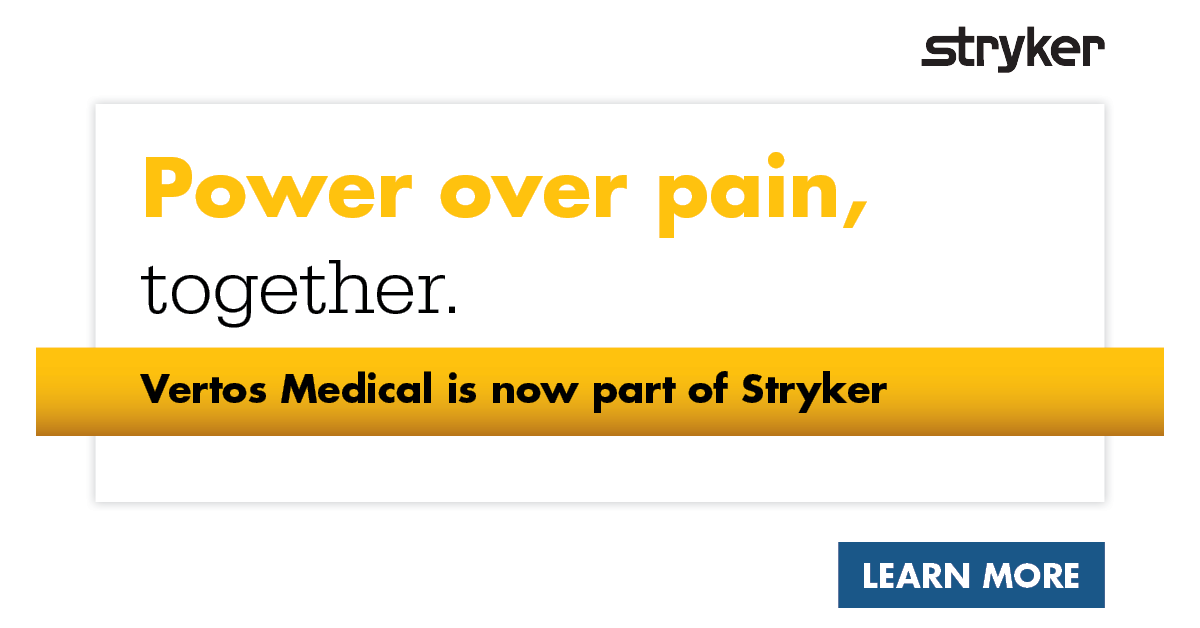ASPN Abstract: Single-Center Comparison of Streamlined Technique Safety for mild® Procedure
Author— Navdeep Singh Jassal, MD and Christine Christensen, MSN, APRN Published July 22, 2021
The following study, “Single-Center Comparison of Streamlined Technique Safety for mild® Procedure: Measuring Incidence of Postoperative Complications Compared to Standard Approach,” evaluates the safety of the Streamlined Technique in patients treated consecutively by a single center. As the mild® Procedure has become more widespread in clinical practice, there has been an evolution from the Standard Approach to the Streamlined Technique, a less invasive procedural approach. Dr. Navdeep Jassal and Christine Christensen, MSN, APRN, of the Spine & Pain Institute of Florida, evaluated 78 mild® patients treated using either the Streamlined Technique or the Standard Approach and measured the occurrence of postoperative complications. View the abstract poster below to discover the results of this study, and learn why the mild® Procedure should be considered the first-line intervention for patients with lumbar spinal stenosis after conservative treatments have been exhausted.

Watch Dr. Jassal and Christine Christensen present their abstract from the American Society of Pain and Neuroscience’s (ASPN) Third Annual Conference, where they discuss why the Streamlined Technique is a more minimally invasive procedural approach for the mild® Procedure and comparable to the Standard Approach in terms of its safety profile.
Eager to further understand the mild® Procedure and the technique described above? Contact Vertos Medical to learn more about the Streamlined Technique or check out the animation and physician experience from Dr. Jassal in this Procedure Evolution blog.
Navdeep Jassal, MD (00:01)
Hello, my name is Navdeep, Dr. Navdeep Jassal from the Spine Institute of Florida in Lakeland, Florida. I’m here to discuss a little bit about a study that is very meaningful to myself and especially my patients in my practice. We’re going to talk a little bit about the Streamlined Approach for the minimally invasive lumbar decompression or the mild® Procedure, and how that’s really changed the way I’ve practiced. We’re going to talk specifically about the safety profile for this particular technique and its comparison to the standard or the classical approach that we’ve used for years.
So what we did was we did a retrospective chart review on our patients and we just wanted to measure the incidence of postoperative complications of the Streamlined Technique compared to the Standard Approach. And we know that the Standard Approach is a very safe as well as an efficacious procedure, and we’ve seen this really time and time again, but classically we’ve seen this from the RCT from the MiDAS ENCORE study, which showed the approach of the Standard Approach, comparing the epidural steroid injection, which is the standard procedure that you do for patients with lumbar spinal stenosis with neurogenic claudication. And then comparing that with the mild® or the minimally invasive lumbar decompression procedure.
I wanted to take this a step further and I wanted to make sure that the complication rate was pretty much the same, which was extremely rare, comparing the Streamlined Approach with the Standard Approach and that’s simply what we did in this retrospective chart review in our practice. I’m going to turn it over to Christine Christensen, who is going to talk a little bit about the data and dive really further into the data because I think it’s just quite interesting.
Christine Christensen, MSN, APRN (02:06)
Hi, I’m Christine Christenson. I’m the Nurse Practitioner that works with Dr. Jassal here in Lakeland, Florida. As part of my practice here, Dr. Jassal was able to include me in generating data and analyzing that data for our research study here looking at the efficacy and safety of the Streamlined Technique. Now, data collection for this study consisted of reviewing charts on 78 patients that had the mild® Procedure performed for them. Dr. Jassal started doing the Streamlined Technique after certain dates.
So we looked at the date and the operative notes for those patients to verify that they did get the Streamlined Technique in the operating room. Of those patients, 100% had confirmed central spinal stenosis on MRI. They also had ligamentum flavum hypertrophy, degenerative disc disease with disc bulges, and facet arthropathy. Of the 78 patients, 97% had concurrent foraminal stenosis. So when we broke that down to the patients who had the Streamlined Technique after Dr. Jassal was trained in proper performance of the technique, we had 44 “streamlined” patients and then 34 patients who had the Standard Approach for the mild® Procedure.
So we took the 44 patients with the Streamlined Technique and the 34 Standard Approach patients and compared occurrence of postoperative complications, including reoperation, device- and procedure-related AEs, serious AEs, and lumbar spine fractures. We also did include removal of hardware, although we do know a big pro of the mild® Procedure is that there is no hardware placed into the patient, really maximizing patient benefit and minimizing risks for patients. This study did show that the Streamlined Technique did not have any increase in risk for patients versus the Standard Approach.
Navdeep Jassal, MD (04:13):
So in conclusion with our study, the Streamlined Technique is a more minimally invasive procedural approach for the mild® Procedure and it’s even comparable in terms of safety profile to the Standard Technique or the Standard Approach. There’s really no increased risk of serious postoperative complications to the patients. And we know that it’s comparable to the data that was shown in the ENCORE study or the RCT in the past.
Also, the mild® Procedure should be considered first-line intervention for patients with lumbar spinal stenosis, with neurogenic claudication symptoms, in a state where they know that they have at least 2.5 millimeters of ligamentum flavum on an MRI exam or a CAT scan study. So really they should be considered first-line intervention after conservative therapy is tried and even after the first epidural steroid injection is completed for your patient.
About Dr. Navdeep Jassal
 Navdeep Jassal, MD, is a Physiatrist and Interventional Pain Physician with a Fellowship in Pain Medicine from University of South Florida Morsani College of Medicine and board certifications in Pain Medicine and Physical Medicine and Rehabilitation. He completed a Residency in Physical Medicine and Rehabilitation at the Zucker School of Medicine at Hofstra/Northwell and received his Doctor of Medicine from Ross University School of Medicine. Dr. Jassal currently serves as an Assistant Professor for the Department of Physical Medicine & Rehabilitation at the University of Central Florida as well as an Assistant Clinical Professor for the University of South Florida’s Pain Medicine Fellowship program. Dr. Jassal is the Young Guys Co-chair for the American Society of Pain & Neuroscience (ASPN), Secretary for the Florida Society of Pain & Neuroscience (FSPN) and Section Editor for the Pain Physician Journal. He holds memberships with the American Society of Interventional Pain Physicians (ASIPP), Florida Medical Association (FMA), North American Neuromodulation Society (NANS), International Neuromodulation Society (INS), Florida Association of Physicians of Indian Origin (FAPI) and Association of Academic Physiatrists.
Navdeep Jassal, MD, is a Physiatrist and Interventional Pain Physician with a Fellowship in Pain Medicine from University of South Florida Morsani College of Medicine and board certifications in Pain Medicine and Physical Medicine and Rehabilitation. He completed a Residency in Physical Medicine and Rehabilitation at the Zucker School of Medicine at Hofstra/Northwell and received his Doctor of Medicine from Ross University School of Medicine. Dr. Jassal currently serves as an Assistant Professor for the Department of Physical Medicine & Rehabilitation at the University of Central Florida as well as an Assistant Clinical Professor for the University of South Florida’s Pain Medicine Fellowship program. Dr. Jassal is the Young Guys Co-chair for the American Society of Pain & Neuroscience (ASPN), Secretary for the Florida Society of Pain & Neuroscience (FSPN) and Section Editor for the Pain Physician Journal. He holds memberships with the American Society of Interventional Pain Physicians (ASIPP), Florida Medical Association (FMA), North American Neuromodulation Society (NANS), International Neuromodulation Society (INS), Florida Association of Physicians of Indian Origin (FAPI) and Association of Academic Physiatrists.
About Christine Christensen, MSN, APRN

Christine Christensen is a Nurse Practitioner who works as an Advance Practice Provider at the Spine & Pain Institute of Florida and partners closely with Dr. Navdeep Jassal. She completed her Bachelor of Science in Neuroscience at Brigham Young University. Christine then earned a Bachelor of Science in Nursing from the University of North Carolina at Chapel Hill and earned her Master of Science in Nursing at the University of Alabama at Birmingham.
Benyamin RM, Staats PS, MiDAS ENCORE Investigators. mild® is an effective treatment for lumbar spinal stenosis with neurogenic claudication: MiDAS ENCORE Randomized Controlled Trial. Pain Physician. 2016;19(4):229-242.
Mekhail N, Costandi S, Abraham B, Samuel SW. Functional and patient-reported outcomes in symptomatic lumbar spinal stenosis following percutaneous decompression. Pain Pract. 2012;12(6):417-425. doi:10.1111/j.1533-2500.2012.00565.x.
2012 data from Health Market Sciences report for Vertos Medical 2013.
Data on file with Vertos Medical.
Staats PS, Chafin TB, Golvac S, et al. Long-term safety and efficacy of minimally invasive lumbar decompression procedure for the treatment of lumbar spinal stenosis with neurogenic claudication: 2-year results of MiDAS ENCORE. Reg Anesth Pain Med. 2018;43:789-794. doi:10.1097/AAP.0000000000000868.
Based on mild® Procedure data collected in all clinical studies. Major complications are defined as dural tear and blood loss requiring transfusion.
MiDAS ENCORE responder data. On file with Vertos Medical.
Jain S, Deer TR, Sayed D, et al. Minimally invasive lumbar decompression: a review of indications, techniques, efficacy and safety. Pain Manag. 2020;10(5). https://doi.org/10.2217/pmt-2020-0037. Accessed June 1, 2020.
Deer TR, Grider JS, Pope JE, et al. The MIST Guidelines: the Lumbar Spinal Stenosis Consensus Group guidelines for minimally invasive spine treatment. Pain Pract. 2019;19(3)250-274. doi:10.1111/papr.12744.
Hansson T, Suzuki N, Hebelka H, Gaulitz A. The narrowing of the lumbar spinal canal during loaded MRI: the effects of the disc and ligamentum flavum. Eur Spine J. 2009;18(5):679-686. doi:10.1007/s00586-009-0919-7.
Treatment options shown are commonly offered once conservative therapies (e.g., physical therapy, pain medications, chiropractic) are not providing adequate relief. This is not intended to be a complete list of all treatments available. Doctors typically recommend treatments based on their safety profile, typically prioritizing low risk/less aggressive procedures before higher risk/more aggressive procedures, but will determine which treatments are appropriate for their patients.
The mild® Procedure is a minimally invasive treatment for lumbar spinal stenosis. As with most surgical procedures, serious adverse events, some of which can be fatal, can occur, including heart attack, cardiac arrest (heart stops beating), stroke, and embolism (blood or fat that migrates to the lungs or heart). Other risks include infection and bleeding, spinal cord and nerve injury that can, in rare instances, cause paralysis. This procedure is not for everyone. Physicians should discuss potential risks with patients. For complete information regarding indications for use, warnings, precautions, and methods of use, please reference the devices’ Instructions for Use.
Patient stories on this website reflect the results experienced by individuals who have undergone the mild® Procedure. Patients are not compensated for their testimonial. The mild® Procedure is intended to treat lumbar spinal stenosis (LSS) caused by ligamentum flavum hypertrophy. Although patients may experience relief from the procedure, individual results may vary. Individuals may have symptoms persist or evolve or other conditions that require ongoing medication or additional treatments. Please consult with your doctor to determine if this procedure is right for you.
Reimbursement, especially coding, is dynamic and changes every year. Laws and regulations involving reimbursement are also complex and change frequently. Providers are responsible for determining medical necessity and reporting the codes that accurately describe the work that is done and the products and procedures that are furnished to patients. For this reason, Vertos Medical strongly recommends that you consult with your payers, your specialty society, or the AMA CPT regarding coding, coverage and payment.
Vertos Medical cannot guarantee coding, coverage, or payment for products or procedures. View our Billing Guide.
Vertos is an equal employment opportunity workplace committed to pursuing and hiring a diverse workforce. We strive to grow our team with highly skilled people who share our culture and values. All qualified applicants will receive consideration for employment without regard to sex, age, color, race, religion, marital status, national origin, ancestry, sexual orientation, gender identity, physical & mental disability, medical condition, genetic information, veteran status, or any other basis protected by federal, state or local law.
Hall S, Bartleson JD, Onofrio BM, Baker HL Jr, Okazaki H, O’Duffy JD. Lumbar spinal stenosis. Clinical features, diagnostic procedures, and results of surgical treatment in 68 patients. Ann Intern Med. 1985;103(2):271-275. doi:10.7326/0003-4819-103-2-271.
Kalichman L, Cole R, Kim DH, et al. Spinal stenosis prevalence & association with symptoms: The Framingham Study. Spine J. 2009;9(7):545-550. doi:10.1016/j.spinee.2009.03.005.
Fukusaki M, Kobayashi I, Hara T, Sumikawa K. Symptoms of spinal stenosis do not improve after epidural steroid injection. Clin J Pain. 1998;14(2):148-151. doi:10.1097/00002508-199806000-00010.
Mekhail N, Costandi S, Nageeb G, Ekladios C, Saied O. The durability of minimally invasive lumbar decompression procedure in patients with symptomatic lumbar spinal stenosis: Long-term follow-up [published online ahead of print, 2021 May 4]. Pain Pract. 2021;10.1111/papr.13020. doi:10.1111/papr.13020
Friedly JL, Comstock BA, Turner JA, et al. Long-Term Effects of Repeated Injections of Local Anesthetic With or Without Corticosteroid for Lumbar Spinal Stenosis: A Randomized Trial. Arch Phys Med Rehabil. 2017;98(8):1499-1507.e2. doi:10.1016/j.apmr.2017.02.029
Pope J, Deer TR, Falowski SM. A retrospective, single-center, quantitative analysis of adverse events in patients undergoing spinal stenosis with neurogenic claudication using a novel percutaneous direct lumbar decompression strategy. J Pain Res. 2021;14:1909-1913. doi: 10.2147/JPR.S304997
Pryzbylkowski P, Bux A, Chandwani K, et al. Minimally invasive direct decompression for lumbar spinal stenosis: impact of multiple prior epidural steroid injections [published online ahead of print, 2021 Aug 4]. Pain Manag. 2021;10.2217/pmt-2021-0056. doi:10.2217/pmt-2021-0056
Abstract presented at: American Society of Pain and Neuroscience Annual Conference; July 22-25, 2021; Miami Beach, FL.
Mobility Matters: Low Back Pain in America, Harris Poll Survey, 2022. View data and full summary here.
Deer TR, Grider JS, Pope JE, et al. Best Practices for Minimally Invasive Lumbar Spinal Stenosis Treatment 2.0 (MIST): Consensus Guidance from the American Society of Pain and Neuroscience (ASPN). J Pain Res. 2022;15:1325-1354. Published 2022 May 5. doi:10.2147/JPR.S355285.

